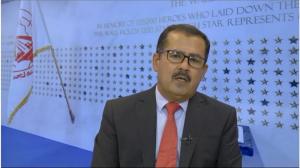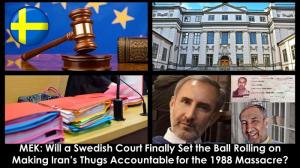(Video) The 1988 Massacre of Political Prisoners in Iran: Eyewitness Accounts, Gholamreza Jalal

(PMOI / MEK Iran) and (NCRI): Gholamreza Jalal, a member of the People’s Mojahedin Organization of Iran, MEK. He was arrested in 1980, two years after the anti-monarchy revolution, and he was in various prisons in Tehran, Evin, Ghezel Hesar, and Gohardasht, until 1986.

(PMOI / MEK Iran) and (NCRI): The 1988 massacre did not just happen. It was rooted in a fundamental conflict between the people of Iran, demanding freedom, democracy, and economic and social development after the overthrow of the Shah.

(PMOI / MEK Iran) and (NCRI): The authorities had already paved the way to massacre all the prisoners defending the Mojahedin-e-Khalq, MEK, and their causes. One day, Mortazavi came into the ward, and the prisoners asked him to resolve a series of issues and problems.

(PMOI / MEK Iran) and (NCRI): In July 1988, Ruhollah Khomeini, issued a decree, stating that all the political prisoners who remain steadfast in their support for the Iranian opposition movement, the People’s Mojahedin Organization MEK.

(PMOI / MEK Iran) and (NCRI): Upon Khomeini’s fatwa, ‘Death Commissions‘ were formed in Tehran and across Iran. The prisoners were brought before the Commission (three to four members), and their fates were decided in a few minutes.

(PMOI / MEK Iran) and (NCRI): “We urge the international community to recognize the massacre of 30,000 political prisoners in 1988 as genocide and a crime against humanity,”.
Raisi, the key member of the Death Commission, has been appointed as the president of the regime. He must be prosecuted in the International Court of Justice.
Eyewitness Mohammad Gholamreza Jalal
I am Gholamreza Jalal, a member of the People’s Mojahedin Organization of Iran, MEK. I was arrested in 1980, two years after the anti-monarchy revolution, and I was in various prisons in Tehran, Evin, Ghezel Hesar, and Gohardasht, until 1986.
I need to testify that the 1988 massacre was not the beginning of this path. From the beginning, Khomeini wanted to eliminate all the young people who stood up against and resisted his rule. For this reason, during different stages in prison, the prison officials began screening political prisoners.
They separated the ones they regarded as more steadfast in their beliefs in Ghezel Hesar and Gohardasht prisons. For example, the prisoners in ward six of Ghezel Hesar Prison were held under a lot of pressure. Also, among the female political prisoners, ward Eight in Ghezel Hesar was separated, and prisoners were subjected to various forms of torture. The torture was a prelude to what they had decided to do, massacring all political prisoners.
They told us their decision at various times without any hesitation, saying that we would not let you leave alive. And they used to say, “You will only leave here, dead.” Or they said that the grenades were ready in case of an event outside prisons. We would drop two grenades in each cell and finish the job. Lajevardi (the infamous butcher of Evin Prison) when he came to inspect the cells, the first sentence he repeatedly said was that you would not leave here alive.
You must have heard about the two-minute trials. You might think that a lot of political prisoners had been indicted. But that was not the case. None of those arrested in the year 1980 had committed any crime at all. Many, like me, were arrested just for distributing the MEK’s publications. Many were arrested for participating in a rally.
With the start of the (Iran and Iraq) war, many of my friends, very young at the time, had gone (to the fronts) to defend the cities against the Iraqi invasion but were arrested, and after being held in various prisons, they were finally sent to Ghezel Hesar or Evin prisons and were executed during the 1988 massacre.
In ward six of Ghezel Hesar Prison, they had made the situation very grueling to make it unendurable for the prisoners. They identified those political prisoners who were more steadfast in their beliefs and put more pressure on them in the same ward. For example, you may find it hard to imagine, but in ward six of Ghezel Hesar in the last six cells, up to 40 people were held in each cell.
In our cell (number 5), the least crowded, there were 33 prisoners. Cell number 4 had 41 prisoners. The prisoners were kept in a very tight position. After that, they took us to a dungeon called Gavdani.
There, to break the prisoners’ resistance, they starved us. For example, they gave us one spoonful of food every day and wanted to torture us in this way. Then they took us to the cage. I was kept in a small cage for a long time, to the extent that my body shape changed. I was also kept inside a coffin for a long time. When none of these measures worked, to break our resistance, we were transferred to solitary confinements in Gohardasht Prison, along with a large number of other political prisoners.
And now I want to tell you about the fate of my friends that we started our political activities together. We were taken to Gohardasht prison in different wards. Some were kept in solitary confinement in Gohardasht for 2-3 years. At first, in solitary confinement, they tried to break us by leaving us alone and under stress. But then they started torturing as well. But again, they could not reach their goals.
I was released in 1986, but they kept many of my friends in prison. There were about 200 of my friends who, like me, were arrested for political activities (in the year 1980), 80 of whom were in Evin Prison in different wards. I have the names of 32 of them, which I will show you. These are the same people who were arrested with me in 1980.
We were friends, and we were kept in the same cell. After I was released, they were kept in prison and were hanged in 1988. Among them were: Saeed Abutorabi, Hassan Afshar, Davood Azarang, Saeed Moravej, Bahman Musapour, Dr. Farzin Nosrati, Morteza Pahlavan, Seyed Hassan Khansari, Hossein Kaffashian, and the rest of my friends in Gohardasht prison.
They were executed because they stood by their principles and paid the price for the freedom of the Iranian people. Now, the same officials, who perpetrated the massacre of our friends, tortured us, and signed the execution order of our friends, are promoted to the highest positions in this regime. In particular, Ebrahim Raisi, one of the key members of the Death Commission, has been appointed as the president of the regime.
Other henchmen, for example, Mostafa Pour Mohammadi and Alireza Avaei, were the regime’s Ministers of Justice in the Rouhani’s government, one after another. Ebrahim Raisi was previously the Judiciary Chief and is now the president.
I call on the international community and all politicians in the world not to turn a blind eye to this issue. The culprits of the 1988 massacre should be exposed. No one should enter into a trade with them. They must be prosecuted in the International Court of Justice, and we hope that similar to Hamid Noury’s case, the international community can help us bring these criminals to justice.
Shahin Gobadi
NCRI
+33 6 51 65 32 31
email us here
The 1988 Massacre of Political Prisoners in Iran: Eyewitness Accounts, Gholamreza Jalal
Legal Disclaimer:
EIN Presswire provides this news content "as is" without warranty of any kind. We do not accept any responsibility or liability for the accuracy, content, images, videos, licenses, completeness, legality, or reliability of the information contained in this article. If you have any complaints or copyright issues related to this article, kindly contact the author above.


